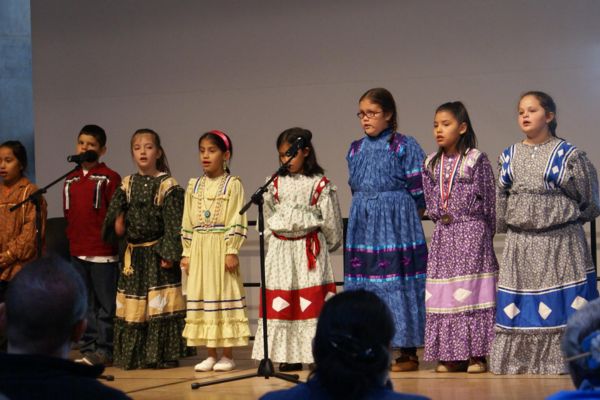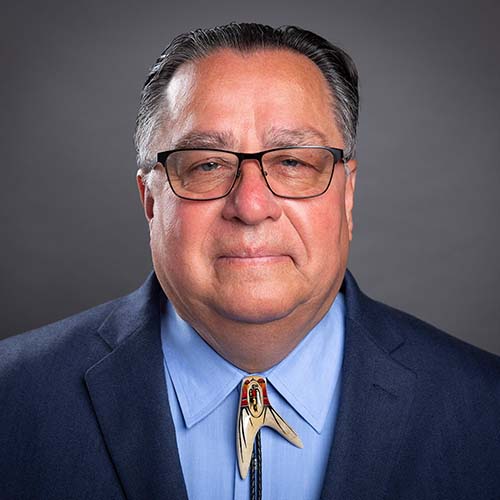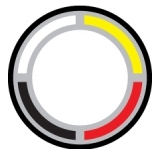
- Details
- By Native News Online Staff
Since its inception in 2003, the Native American Youth Language Fair has brought pre-K through 12th-grade Native students from around the United States to the Sam Noble Museum in Norman, Oklahoma, to learn the native languages of the nearly 40 different Native American tribes in the state.
Loss of language reaches all corners of Indian Country and is one of the reverberating effects of the Board School Era. The era, spanning the late mid-1800s to the 1960s, is marked by a government-sanctioned campaign of forced assimilation during which Native children were ripped from their families and placed in boarding schools. While at the boarding schools, Native children were stripped of their culture and forbidden to speak their Native languages.
According to the National Museum for the American Indian, there were historically approximately 500 distinct Native languages spoken in North America. In 2019, High Country News reported that of the 115 Native languages today, 99% are in danger of extinction.
Raine Heaton, Assistant Curator of Native American Language at the Sam Noble Museum and director of the fair, told OKCFox that the grant will help fund and expand this year's fair.
"The Language fair is the biggest and best-attended event that the museum hosts annually," Heaton said. "Usually, we have something like 30/40 different languages being spoken in the same place on the same day, and I think this is the only place maybe in the nation that we can say that that happens for native languages."
This year's Native American Youth Language Fair will be held April 1st and 2nd at the Sam Noble Museum on the campus of the University of Oklahoma. Speakers include Dr. Mary S. Linn, the Curator of cultural and linguistic revitalization at the Smithsonian Center for Folklife and Cultural Heritage; Geneva Navarro (Comanche), a long-time teacher of the Comanche language; and Quinton Roman Nose (Cheyenne Arapahoe), Executive Director of Tribal Education Departments National Assembly.
Dr. Linn is the founding Curator of the Native American Languages Collection It is free and open to the public. Click here for more information.
More Stories Like This
American Indian College Fund Raises Alarm Over Plan to Shift Native Programs Away From the Dept. of EducationMacKenzie Scott Foundation Gives $5 Million Contribution to Little Priest Tribal College
Tribal Leaders Push Back on Dismantling of U.S. Department of Education
American Indian College Fund Names 12 Student Ambassadors for 2025–26
2025 State of the American Indian College Fund Released for Native American Heritage Month
Help us tell the stories that could save Native languages and food traditions
At a critical moment for Indian Country, Native News Online is embarking on our most ambitious reporting project yet: "Cultivating Culture," a three-year investigation into two forces shaping Native community survival—food sovereignty and language revitalization.
The devastating impact of COVID-19 accelerated the loss of Native elders and with them, irreplaceable cultural knowledge. Yet across tribal communities, innovative leaders are fighting back, reclaiming traditional food systems and breathing new life into Native languages. These aren't just cultural preservation efforts—they're powerful pathways to community health, healing, and resilience.
Our dedicated reporting team will spend three years documenting these stories through on-the-ground reporting in 18 tribal communities, producing over 200 in-depth stories, 18 podcast episodes, and multimedia content that amplifies Indigenous voices. We'll show policymakers, funders, and allies how cultural restoration directly impacts physical and mental wellness while celebrating successful models of sovereignty and self-determination.
This isn't corporate media parachuting into Indian Country for a quick story. This is sustained, relationship-based journalism by Native reporters who understand these communities. It's "Warrior Journalism"—fearless reporting that serves the 5.5 million readers who depend on us for news that mainstream media often ignores.
We need your help right now. While we've secured partial funding, we're still $450,000 short of our three-year budget. Our immediate goal is $25,000 this month to keep this critical work moving forward—funding reporter salaries, travel to remote communities, photography, and the deep reporting these stories deserve.
Every dollar directly supports Indigenous journalists telling Indigenous stories. Whether it's $5 or $50, your contribution ensures these vital narratives of resilience, innovation, and hope don't disappear into silence.
 The stakes couldn't be higher. Native languages are being lost at an alarming rate. Food insecurity plagues many tribal communities. But solutions are emerging, and these stories need to be told.
The stakes couldn't be higher. Native languages are being lost at an alarming rate. Food insecurity plagues many tribal communities. But solutions are emerging, and these stories need to be told.
Support independent Native journalism. Fund the stories that matter.
Levi Rickert (Potawatomi), Editor & Publisher

